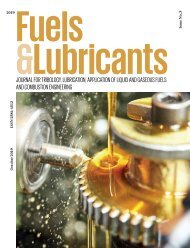Fuels & Lubricants Magazine
Issue No. 2, June 2018
Issue No. 2, June 2018
You also want an ePaper? Increase the reach of your titles
YUMPU automatically turns print PDFs into web optimized ePapers that Google loves.
carbonate = PC; hydrophilic PC =<br />
HPC) had a relatively small effect on<br />
defoaming performance compared<br />
to the non-polar polypropylene<br />
(P). However, the 3D-based defoamer<br />
(HP753N; 0.2% in the MWF<br />
concentrate) maintained superior<br />
persistence even with the polypropylene<br />
(P) filter, while the 2 OMS<br />
products (0.4%) showed increased<br />
foam. Other filtration studies that we<br />
have performed have shown similar<br />
trends.<br />
Washability and Paintability<br />
of 3D Siloxane Technology<br />
Silicone-based defoamers can<br />
cause defects such as craters in<br />
painting operations due to silicone<br />
residue adsorbed on the substrate<br />
surface. Silicone oil droplets can<br />
readily spread on metal surfaces.<br />
This spread layer, which has a low<br />
surface energy, can be particularly<br />
difficult to clean, and even a monolayer<br />
left on the surface can cause<br />
retraction of the applied paint. On<br />
the other hand, defoamers based<br />
on the 3D siloxane technology have<br />
good washability due to optimized<br />
formulation parameters and the 3D<br />
siloxane’s crosslinked nature, which<br />
impedes spreading on the metal<br />
substrate surface. To test this, we<br />
immersed cleaned steel panels in a<br />
semi-synthetic MWF dilution containing<br />
various defoamers, and then<br />
washed with tap water and dried (in<br />
an oven at 50 °C) the panels. Then, a<br />
water-based white primer paint was<br />
applied using a #10 Myer rod. As<br />
shown in Figure 5, the coatings on<br />
the panels that were immersed in the<br />
MWF containing the 3D siloxane<br />
defoamer technology did not show<br />
any defects, while a panel with a silicone<br />
emulsion in the MWF showed<br />
many defects. This observation is<br />
consistent with the many years of<br />
field experience that have demonstrated<br />
the excellent washability<br />
and paintability of the 3D siloxane<br />
technology.<br />
Figure 4. Effects of Filtration Media on Defoamer Performance<br />
FOAM BAN HP753N<br />
Figure 5.<br />
FOAM BAN HP757<br />
10% Silicone Emulsion<br />
Summary and Conclusions<br />
The most effective defoamer technologies<br />
are based on polysiloxane<br />
chemistries, because of their inherently<br />
low surface tensions that are<br />
required by the thermodynamics<br />
of defoaming processes. For MWF,<br />
the 3D siloxane technology provides<br />
a superior level of initial and<br />
persistent defoaming compared to<br />
alternative technologies. In addition,<br />
3D siloxane-based defoamers have<br />
excellent concentrate compatibility,<br />
filterability, and washability/paintability<br />
characteristics.<br />
6 <strong>Fuels</strong>&<strong>Lubricants</strong> No. 2 JUNE 2018







